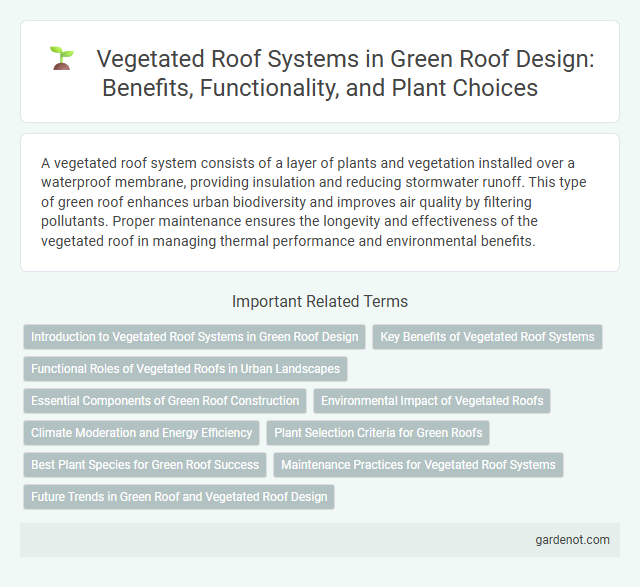A vegetated roof system consists of a layer of plants and vegetation installed over a waterproof membrane, providing insulation and reducing stormwater runoff. This type of green roof enhances urban biodiversity and improves air quality by filtering pollutants. Proper maintenance ensures the longevity and effectiveness of the vegetated roof in managing thermal performance and environmental benefits.
Introduction to Vegetated Roof Systems in Green Roof Design
Vegetated roof systems integrate layers of waterproofing, drainage, growing medium, and vegetation to create sustainable green roofs that improve urban environments. These systems enhance stormwater management, reduce building energy consumption, mitigate urban heat island effects, and promote biodiversity. Advanced designs customize substrate depth and plant selection based on climate, structural constraints, and maintenance capacity to optimize performance and longevity.
Key Benefits of Vegetated Roof Systems
Vegetated roof systems improve stormwater management by absorbing and filtering rainwater, reducing runoff and decreasing the risk of urban flooding. They enhance energy efficiency through natural insulation, lowering heating and cooling costs while contributing to urban heat island mitigation. These green roofs also promote biodiversity by providing habitats for birds, insects, and plants, supporting ecological balance in urban areas.
Functional Roles of Vegetated Roofs in Urban Landscapes
Vegetated roof systems enhance urban landscapes by improving air quality, reducing the urban heat island effect, and managing stormwater through natural absorption and filtration processes. These green roofs support biodiversity by providing habitats for birds, insects, and pollinators, contributing to ecological connectivity within cities. Their insulation properties reduce energy consumption in buildings, promoting sustainable urban infrastructure and lowering greenhouse gas emissions.
Essential Components of Green Roof Construction
A vegetated roof system consists of several essential components including a waterproof membrane, root barrier, drainage layer, filter fabric, growing medium, and vegetation layer. The waterproof membrane prevents water infiltration into the building, while the root barrier protects the membrane from root penetration. The drainage layer facilitates excess water removal, ensuring proper aeration of the growing medium and promoting healthy plant growth.
Environmental Impact of Vegetated Roofs
Vegetated roof systems significantly enhance urban biodiversity by providing habitat for pollinators and bird species, contributing to ecosystem restoration. These green roofs improve air quality by filtering airborne pollutants and reducing carbon dioxide levels, mitigating urban heat island effects. Their stormwater retention capabilities reduce runoff, decreasing the burden on municipal drainage systems and preventing water pollution.
Climate Moderation and Energy Efficiency
Vegetated roof systems significantly enhance climate moderation by reducing urban heat island effects through natural insulation and evapotranspiration processes. These green roofs improve energy efficiency by lowering building cooling and heating demands, resulting in reduced energy consumption and utility costs. Incorporating drought-resistant plants and substrate layers optimizes thermal regulation while promoting sustainable water management.
Plant Selection Criteria for Green Roofs
Plant selection for vegetated roof systems prioritizes drought tolerance, shallow root structures, and low maintenance requirements to ensure long-term survival and performance. Succulents like Sedum species are favored for their resilience to extreme weather, ability to retain moisture, and minimal nutrient needs. Choosing native and climate-adapted plants enhances biodiversity, reduces irrigation demands, and improves the overall ecological benefits of green roofs.
Best Plant Species for Green Roof Success
Succulents such as Sedum species are ideal for green roofs due to their drought tolerance and shallow root systems, ensuring longevity and minimal maintenance. Native grasses and wildflowers enhance biodiversity and support local ecosystems while adapting well to rooftop conditions. Selecting hardy, low-growing perennials like creeping thyme or blue star creeper promotes soil stability and maximizes green roof performance under varying climate conditions.
Maintenance Practices for Vegetated Roof Systems
Routine inspection and upkeep are essential for maintaining the longevity of vegetated roof systems. Key maintenance practices include regular watering, weeding to prevent invasive species, and checking drainage systems to avoid water pooling. Proper fertilization and seasonal plant replacement also enhance the health and performance of green roofs, ensuring optimal growth and structural integrity.
Future Trends in Green Roof and Vegetated Roof Design
Advancements in vegetated roof systems emphasize increased biodiversity through native plant integration and enhanced stormwater management using smart irrigation technology. Future trends include the adoption of lightweight, modular green roof components that facilitate easier installation on diverse building structures. Innovations in sensor-based monitoring enable real-time assessment of plant health, optimizing maintenance and sustainability outcomes in green roof design.
Vegetated roof system Infographic

 gardenot.com
gardenot.com